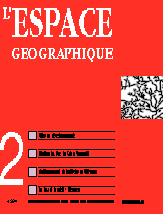

Émile LE BRIS, Christian TAILLARD. Regionalisation and urbanisation in Central Vietnam: the scientific dimensions of regional planning (1 fig.)
The issues of regionalisation and urbanisation in Vietnam are linked to the urbanisation that occurred during the years of partition; the metropolisation of two centres, Hanoi and Ho Chi Minh City; and the strategy of triangular and corridor development distorting the territorial balances of a country with a meridian structure. In central Vietnam there are also the constraints of an intermediate space; two rival capitals Hue, the historic capital and Da Nang, the economic capital; and an international outlook to both the continent and the sea, favoured by the narrow hinterland. In the current context of transition, the State is in competition with new players (families and foreign investors) for the control of land. As the country shifts from endogenous development within national frontiers to development open to the forces of globalisation, the social and spatial structuring of the Vietnamese city will need to be redesigned.
Vincent BERDOULAY, J. Nicholas ENTRIKIN. Place and subject. Theoretical perspectives.
The understanding of modern modes of territoriality makes it necessary to revisit the concept of place. Place must be related to the issues of the subject and identity in the development of modern culture and society. A strong conceptual and methodological convergence links the notions of place, subject, and narrative.
The use of remote-sensing and the GIS for identifying areas suitable for building on a hilly urban site: the case of Yaoundé (Cameroon) (3 tabl., 10 fig.)
Yaoundé, the capital of Cameroon, is characterised by anarchical and precarious spatial expansion and is prone to flooding, erosion and landslides. To reduce the risks of natural disasters, the government needs to implement a development strategy consisting of redirecting urban development and resorbing pockets of urban anarchy (spontaneous districts and precarious housing). Policy-makers will first need to determine which areas are suitable for urban densification and which are not, based on criteria such as altitude, slope and distance from rivers and lakes. Satellite imaging and the GIS are ideally suited to such a task. By combining a wide variety of spatial data from different sources and on different scales, these tools provide concise information incorporating a large number of criteria.
Éric DENIS. Urban growth and socio-spatial dynamics in Cairo between 1950 and 1990 (3 tabl., 12 fig.)
In the last 40 years, Cairo's population growth has been accompanied by a major shift in socio-demographic distribution. By using social area analysis models to measure the spatial structuring of social disparities, we can see how Cairo society has moved from sectoral segmentation reflecting a socio-professional hierarchy to a concentric pattern based increasingly on age differences and family structures.
Mayté BANZO. The urbanisation process of the periurban fringe of Mexico City: a methodological approach (4 fig.)
Since the 1980s, Mexico City's urban expansion has taken on a new form, spurred by the periurban fringe. For our analysis of the urbanisation process of this intermediate space, we have chosen agricultural land as our starting point. Through a strategic approach, we examine the active role played by farmers in the urbanisation process and the nature of the links they maintain with their environment. We thus aim to break down the opposition between urban and rural studies and view the rural periurban fringe as an integrative force.
El Alto de La Paz, a poor mountain city in the heart of Latin America (1 tabl., 4 fig.)
El Alto de La Paz is the poor cousin of Bolivia's biggest city, La Paz. In the past forty years, this peripheral town has experienced rapid spatial expansion and population growth, which has major implications for Bolivia in the future. El Alto is an example of an ongoing urbanisation process, the creation of an impoverished town with numerous problems and an Indian city where life for the poor consists of day-to-day survival. While in many ways typical of the outskirts of Latin America's capital cities, this mountain shanty town also has its own specificities.
Jean-Christophe GAY. Turning constraints to advantages. The development of tourism in the Principality of Monaco (1 tabl., 4 fig.)
The development of tourism in Monaco dates from the establishment of the Monte-Carlo seaside resort in the mid-nineteenth century. Over the past forty years, the principality has engineered a successful transition in the development of its tourism. The micro-state has managed to remain a prestigious destination by improving access and providing wealthy tourists with a safe environment, a series of high-society events and luxury accommodation. In addition to its affluent visitors, it now welcomes millions of sightseers every year and the number of holiday houses has increased considerably. Tourism on the territory of Monaco today is diversifying and spreading.
L’espace géographique 1/98![]()
![]() L’espace géographique 3/98
L’espace géographique 3/98
![]() L’Espace géographique: contents
L’Espace géographique: contents
Last modified: August 5, 1998